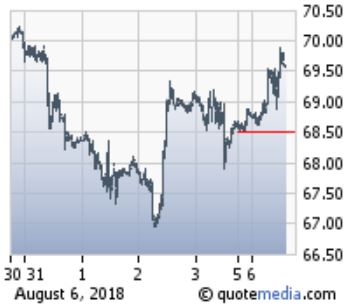U.S. oil transport infrastructure probably contributing price factor, with continued ‘pronounced increases’ in production slimming back due to pipeline constraints
From Reuters
NEW YORK (Reuters) – Oil futures rose on Monday after OPEC sources said Saudi crude production unexpectedly fell in July, raising concerns about global oil supplies as the United States prepares to reinstate sanctions against major exporter Iran.
Brent crude futures rose 94 cents to $74.15 a barrel, a 1.3 percent gain, by 11:25 a.m. EDT.
U.S. West Texas Intermediate (WTI) crude futures rose $1.23 to $69.72 a barrel, a 1.8 percent gain.
Saudi Arabia pumped around 10.29 million barrels per day (bpd) of crude in July, two OPEC sources said on Friday, down about 200,000 bpd from a month earlier.
That came despite a pledge by the Saudis and top producer Russia in June to raise output from July, with Saudi Arabia promising a “measurable” supply boost.
“The Saudis are reining in production gains in an attempt to maintain Brent pricing” at about $70 to $75 a barrel, Jim Ritterbusch, president of Ritterbusch and Associates, said in a note.
U.S. investment bank Jefferies said in a note that “the Saudi and Russian production surges appear to be more limited” than expected, adding that the imminent reinstatement of U.S. sanctions against Iran also fed bullish sentiment.
Washington is due to reinstate some sanctions against Iran that it suspended after a 2015 deal between world powers and Tehran that sought to curb Iran’s nuclear program.
Some of the sanctions will come back on Tuesday at 12:01 a.m. EDT. The United States also plans to re-introduce sanctions on Iranian oil in November, which could dent the OPEC member’s output.
Renewed sanctions are part of Trump administration’s strategy to deny resources to the Iranian leadership.
Washington wants as many countries as possible to cut imports of Iranian oil to zero, a senior U.S. administration official said in a telephone press briefing.
Most Iranian crude exports go to China and India, but roughly 20 percent go to Europe, where refiners have already cut their purchases.
Meanwhile, U.S. energy companies last week cut oil rigs for a second time in the past three weeks as the rate of growth has slowed over the past couple of months.
Oil prices “may also be finding support from oil transport infrastructural problems in the U.S.,” said Commerzbank analysts in a note.
“Admittedly, oil production there is surging from one record high to the next. However, low pipeline capacities in particular are preventing any more pronounced increase and are delaying the rebalancing of global supply and demand.”


